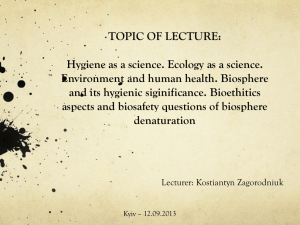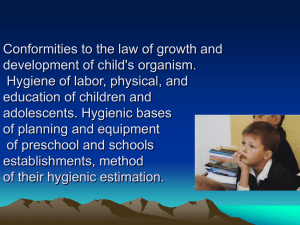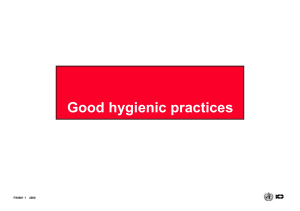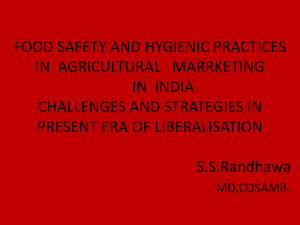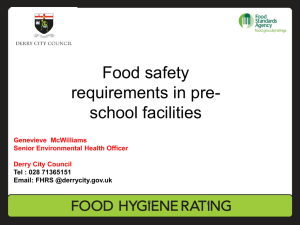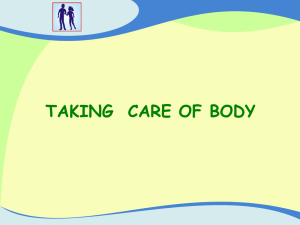食品機械設備與衛生安全之關聯二 - Taiwan International Tradeshows
advertisement
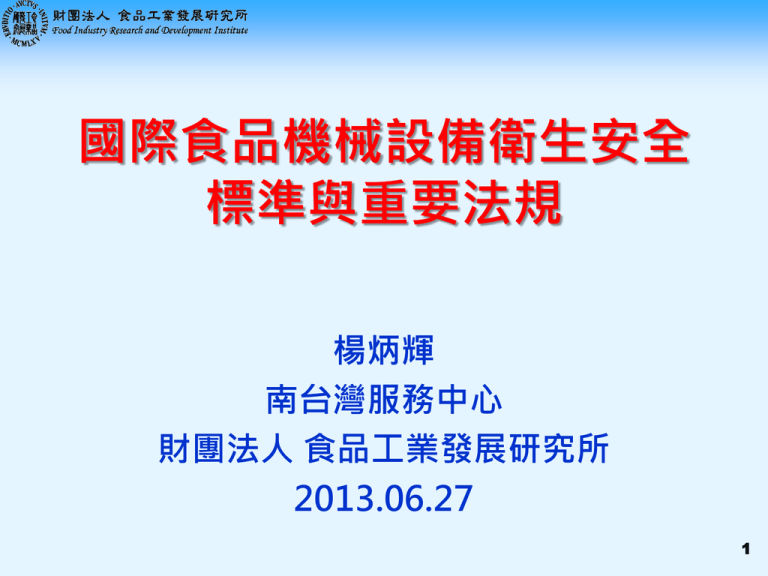
國際食品機械設備衛生安全 標準與重要法規 楊炳輝 南台灣服務中心 財團法人 食品工業發展研究所 2013.06.27 1 簡報大綱 一、食品機械設備與衛生安全之關聯 二、歐美食品與設備衛生重要法規 三、歐美自願性相關標準 四、設備衛生設計相關建議或標準 五、台灣相關設備衛生規範 六、未來展望 2 Codex Alimentarius - Food Hygiene “Food safety” Assurance that food will not cause harm to the consumer when it is prepared and/or eaten according to its intended use. Created in 1963 by FAO and WHO to develop food standards, guidelines and related texts such as codes of practice under the joint FAO/WHO Food Standards Program. 3 Food Safety Equipment / Hardware Process Hygienic Design Criteria Hygiene Food Processing Criteria Machinery directive 2006/42/EC EU-regulations: RE (EC) 178/2002 RE (EC) 852/2004 RE (EC) 2073/2005 - Regulation (EC) 1935/2004 - on materials and articles intended to come into contact with food - Regulation (EU) 10/2011 Plastic materials in food contact - Regulation (EC) 2023/2006 - on good manufacturing practice for materials and articles intended to come into contact with food 4 Hygienic Design of Machinery vs. Hygienic Control of Process Hygienic Design machinery equipment, components installation function cleanability equipment quality risk assessment (machinery) process HACCP, GMP production, process product personal cleaning product quality risk assessment (product) 5 設備規格與衛生等級 工業級與食品級機械設計之差異 工業級機械設計 工業級 食品級機械設計 僅需符合「功能」 需求! 設備功能性 材料選用 質能傳送效率 機構設計 機電整合 程序控制 操作安全性 設備功能性 選用無毒性材料 質能傳送效率 機構設計 機電整合 程序控制 操作安全性 衛生設計 設備滅菌 設備易清洗 食品級 需符合「食用衛生 安全」需求! 6 歐美食品與設備衛生重要法規 7 EU 1. Regulation (EC) 178/2002 on the hygiene of foodstuffs Basic hygiene principles Food & feed business operator: legal responsibility for ensuring product safety Unsafe foodstuffs may not be placed on the market Traceability Consideration of long-term, cumulative effects 8 EU 2. Regulation (EC) 852/2004 on the hygiene of foodstuffs Primary production (Annex I) and further steps (Annex II) Analysis of potential food safety risks and determination of Critical Control Points (Hazard Analysis and Critical Control Points - HACCP) HACCP based on principles of Codex Alimentarius Control and documentation requirement during the whole production process Registration is mandatory for all food manufacturing establishments 9 EU 2. Regulation (EC) 852/2004 on the hygiene of foodstuffs Risk assessment - HACCP Conduct hazard analysis Determine critical control points (CCP’s) Establish critical limit(s) Establish system to monitor CCP’s Establish corrective action Establish verification procedure Establish documentation 10 EU 2. Regulation (EC) 852/2004 on the hygiene of foodstuffs Annex I (primary production) Articles, fittings and equipment must be able to be cleaned and, where necessary, to be disinfected. Annex II (food business operators) Surfaces (including surfaces of equipment) … will require the use of smooth, washable, corrosion resistant and non-toxic materials, …(Chapter II) Articles, fitting and equipment must ….(Chapter V) Be effectively cleaned and, where necessary, disinfected Be so constructed, be of such materials and be kept in such good order, repair and condition as to minimise any risk of contamination. Be installed in such a manner as to allow adequate cleaning of the equipment and the surrounding area. 11 EU 3. Regulation (EC) 853/2004 Specific hygiene rules for food of animal origin (not about equipment) 4. Regulation (EC) 854/2004 Specific rules for the organization of official controls on products of animal origin intended for human consumption (not about equipment) 5. Regulation (EC) 2073/2005 on microbiological criteria for foodstuffs Determining limits for safe food Food safety criteria for best before date (BBD) Process hygiene criteria during manufacturing 12 EU 6. Regulation (EC) 1935/2004 on materials and articles intended to come into contact with food Scope All materials and articles intended to come (prospectively) into contact with food: Processing machinery and filling equipment, Kitchen equipment, container, packaging material. 13 EU Requirement on materials intended to come into contact with food : No human health hazards No indefensible modification of food composition No detraction from organoleptic food properties No misdirection of customers Use “for food contact” or the symbol Traceability on all manufacturing and distribution steps 14 EU 7. Regulation (EC) 2023/2006 Good manufacturing practice for materials and articles intended to come into contact with food 8. Regulation (EU) 10/2011 Plastic materials and articles intended to come into contact with food, revokes Directive 2002/72/EC 15 EU 9. GMP-Directive 2003/94/EC Principles and guidelines of Good Manufacturing Practice in respect of medicinal products for human use and investigational medicinal products for human use. GMP: “Quality assurance system, which controls and manages manufacturing and quality control of foods, pharmaceutical products and medical devices.” GMP-Directive affects: Personnel, premises und equipment of production, Quality control and labeling, Contracted manufacturing and (self-) inspection, Complaints and product recall 16 EU 10. Directive (EC) 2006/42 Annex I 2.1. Food processing machinery and machinery for pharmaceutical and cosmetic products Principles So designed and constructed as to avoid any risk of infection, sickness or contagion. Materials, which are (prospectively) intended to come into contact with Food, Cosmetics, Pharmaceuticals Machine parts / materials in contact with food can be cleaned before each use. Where this is not possible disposable parts must be used. 17 Requirements on machine conditions EU All surfaces including their joining with product contact (exception: disposable parts) must Be smooth, without ridges or crevices Reduce projections, edges and recesses to a minimum Be easily cleaned and disinfected Inside surfaces must have curves of a radius sufficient to allow sufficient cleaning 18 EU Design requirements It must be possible for liquids, gases and aerosols deriving from products as well as from cleaning, disinfecting and rinsing fluids to be completely discharged from the machinery. Machinery must be designed and constructed in such a way as to prevent any substances or living creatures, in particular insects, from entering, or any organic matter from accumulating. Machinery must be designed and constructed in such a way that no ancillary substances, including the lubricants used, that are hazardous to health can come into contact with products. 19 EU Technical file for machinery - 2006/42/EC General description of the machinery Overall drawings, accompanied by all calculation notes, test results Certificates etc. required to check the conformity with the health and safety requirements Documentation on risk assessment demonstrating the procedure followed Standards and other technical specifications used Technical report giving the results of the tests carried out Copy of the instructions for the machinery Internal measures for serial production Implemented to ensure that the machinery remains in conformity with the provisions of this directive 20 EU 歐盟食品機械衛生設計法規 歐洲經濟共同體(EEC)在1998頒布的聯盟法規-歐洲機 械設備指導方針(European Community Machinery Directive) 89/37/EEC為輸入歐盟之機械設備的法規 依據,對機械衛生安全有原則上的要求。 機械衛生設計工程則由歐洲標準化委員會(European Committee for Standardization, CEN)所頒布之食品 加工機械基本概念中的安全條例EN1672-1和衛生條例 EN1672-2 (ISO 14159)所規範。 任何輸入歐盟的食品加工機械設備均須符合上述之法 規,若經EU檢查單位查察不符合規定者,相關單位有 權可沒收與銷毀其設備與產品,嚴重者可勒令設備商 關廠停止生產。 21 USA Legal texts USA Food and Drug Administration (FDA) Food code United States Department of Agriculture (USDA) Legislation on machines processing agricultural products FDA USDA Work jointly together with other local, federal and national organizations 22 USA Food and Drug Administration (FDA) US authority Monitors and regulates manufacturing and trading of pharmaceuticals, cosmetics and food Monitors by regular inspection (incl. NONUSA) No accreditation of machine components and equipment Demand for FDA-compliant materials according to 21CFR 174-178 23 USA 24 USA 美國食品機械衛生設計法規 美國針對食品機械設備設計尚無強制之「法律」 規範;FDA亦僅對設備設計提出基本設計原則之 要求。 Sec. 110.40 Equipment and utensils. All plant equipment and utensils shall be so designed and of such material and workmanship as to be adequately cleanable, and shall be properly maintained. The design, construction, and use of equipment and utensils shall preclude the adulteration of food with lubricants, fuel, metal fragments, contaminated water, or any other contaminants. All equipment should be so installed and maintained as to facilitate the cleaning of the equipment and of all adjacent spaces. Food contact surfaces shall be corrosion-resistant when in contact with food. They shall be made of nontoxic materials and designed to withstand the environment of their intended use and the action of food, and, if applicable, cleaning compounds and sanitizing agents. Food contact surfaces shall be maintained to protect food from being contaminated by any source, including unlawful indirect food additives. Seams on food-contact surfaces shall be smoothly bonded or maintained so as to minimize accumulation of food particles, dirt, and organic matter and thus minimize the opportunity for growth of microorganisms. Equipment that is in the manufacturing or food-handling area and that does not come into contact with food shall be so constructed that it can be kept in a clean condition. 25 Voluntary standards Non-legal requirements Standards are recommendations Reflect state of the technology 26 國際食品機械衛生標準制定機構 國際標準 國際標準組織(ISO)及國際乳業聯合會(IDF) 區域標準 歐洲標準化委員會(CEN) 國家標準 美國國家標準協會(ANSI)、德國標準化學會(DIN)、瑞 典國家標準(SMS)及日本工業規格協會(JIS) 團體標準 3A衛生標準、歐洲衛生設備設計組織(EHEDG) 公司標準 Tri-Clover等,由各公司或企業制定與採行 27 美國國家標準學會 American National Standards Institute, ANSI 成立於1918年,負責所有技術領域及國家標準之建立 - 美國材料試驗協會(ASTM) - 美國機械工程師協會(ASME) - 美國礦業與冶金工程師協會(ASMME) - 美國土木工程師協會(ASCE) - 美國電氣工程師協會(AIEE) 共同成立美國工程標準委員會(AESC) 1966年改為現名美國國家標準學會(ANSI) 3-A設備材料標準大多採用ASME與ASTM之規定 (http://www.ansi.org) 28 德國標準化學會 Deutsches Institut fur Normung (German Institute for Standardization) 1975年,德國政府將DIN作為國家標準體系,主要任務為建 立各技術領域之國家標準。 關於衛生設計,德國聯邦衛生部(German Federal Ministry of Health)指示DIN與聯邦衛生局(Federal Board of Healt h)合作,共同建立衛生標準。 大多數DIN標準為德國市場而制定,但在歐盟國家中最被廣 泛引用。 標準內容包含商業、服務業、工業、科技等。 部分DIN標準已被規為國際標準,標記為“DIN/ISO”。 (http://www.din.de) 29 歐洲標準化委員會 European Committee for Standardization 歐洲標準委員會(CEN)組合了不同國際組織 來制定標準 “CEN/TC 153 /4/” 標準-對於食品加工 機械之安全及衛生要求有明確之定義 “CEN/TC 153 N 108 E” 標準-定義人類 及動物食用產品之機械衛生要求 定義衛生設備加工可能產生的危險性,並提 出防範措施 30 European Committee for Standardization CEN/TC 153: Machinery intended for use with foodstuffs and feed ISO/TC 199: Safety of machinery EN 1672-2:2005, A1:2009: Food processing machinery – Basic concepts – Part 2: Hygiene requirements Other technical CEN-commitees: TC 194 Utensils in contact with food TC 197 Pumps TC 146 Packaging machines – safety TC 188 Conveyor belts 31 EN 1672-2:2005, A1:2009 Food processing machinery Basic concepts - Part 2: Hygiene requirements Hazard analysis and measures during application of food processing machinery Basic concepts of hazards for food, caused by food processing machinery Distinguish between food area, splash area and non-food area Accomplishment of a risk analysis for food processing machinery based on hygienic aspects Hygienic requirements on materials and design Examples for hygienic and non-hygienic design and implementation Verification of hygiene requirements Information for use 32 EN 1672-2:2005, A1:2009 Food processing machinery Basic concepts - Part 2: Hygiene requirements - Risk assessment Determination of the limits of the machinery - Considering: equipment life, expected use Training level of the user Estimation of the hygiene risks - Severity and likelihood of occurrence Assessment of hygiene risks - Hygiene risks minimisation - Are they significant? Verify that hazard has been eliminated or the risk reduced due to design and hygienic measures Enough and clear information accompanying the equipment (i.e. hygienic working practices) 33 Other standards developed by CEN/TC 153 Standard reference Title EN 12331:2003 Food processing machinery - Mincing machines Safety and hygiene requirements EN 12463:2004 Food processing machinery - Filling machines and auxiliary machines - Safety and hygiene requirements EN 13570:2005 Food processing machinery - Mixing machines Safety and hygiene requirements EN 1678:1998 Food processing machinery - Vegetable cutting machines - Safety and hygiene requirements EN 1974:1998 Food processing machinery - Slicing machines Safety and hygiene requirements In total more than 60, available at European national standardisation organization 34 ISO 14159:2002 Safety of machinery Hygiene requirements for machinery design Basic Regulation Equipment safety, Hygiene, Design, Consumer protection, Environmental cleanliness, Cleaning, Maintenance, Risk assessment, Biological hazards, Microorganisms, Grades (quality), Instructions for use Same approach as EN 1672-2 35 Standards / Recommendations 36 European Hygienic Engineering & Design Group Founded in 1989, it is a consortium of equipment manufacturers, food companies, research and educational institutes and public health authorities. Objectives: Provides practical guidance on the hygienic engineering aspects of manufacturing safe and wholesome food Identifies areas where knowledge of hygienic design in insufficient Develops and publishes test methods for hygienic design assessment Safe and hygienic production of food and guidance to equipment manufacturers and users on compliance with national and international legislation 37 European Hygienic Engineering & Design Group Currently more than 600 members Equipment certification by EHEDG-authorized institutes Subgroup clusters: Principles Equipment and Components Processing, Services and Utilities Training and Education Cooperation with: 3-A is a member of EHEDG and vice versa 38 EHEDG Subgroups Each Subgroup is responsible for an area of expertise, and within each area certain specific scopes are defined. Subgroups with the same focus are pooled together in Subgroup cluster. The contact is the liaison for the cluster and member of the Executive Committee. Subgroup cluster Processing, services & utilities Contact: Dr. John Holah Training & Education Contact: Knuth Lorenzen Subgroups Air handling Electrical installations Heat treatments Lubricants Process water Meat processing Facilitator Toolbox Training 39 EHEDG Subgroups Subgroup cluster Equipment & Components Contact: Jacques Kastelein Principles Contact: Dr. Jürgen Hofmann Subgroups Cooling and Chilling Fish processing equipment Meat processing equipment Mechanical seals Packing machines Pipe and couplings Pumps Sensors Valves Building Design Design principles Dry materials handling Hygienic systems integration Materials of construction Testing and Certification Welding 40 Some published guidelines out of about 40 Doc 2: A method for assessing the inplace cleanability of food processing equipment, 2004 Doc 8: Hygienic equipment design criteria, 2004 Doc 14: Hygienic design of valves for food processing, 2004 Doc 27: Safe Storage and Distribution of Water in Food Factories Doc 35: Hygienic welding of stainless steel tubing in the food processing industry, 2006 41 Guidelines Doc. Subjects 1 Microbiologically safe continuous pasteurization of liquid food 2 A method for assessing the in-place cleanability of food processing equipment. 3 Microbiologically safe aseptic packing of food products. 4 A method for the assessment of in-line pasteurisation of food processing equipment. 5 A method for the assessment of in-line sterilisability of food processing equipment. 6 The microbiologically safe continuous flow thermal sterilisation of liquid foods. 7 A method for the assessment of bacteria-tightness of food processing equipment. 8 Hygienic equipment design criteria. 9 Welding stainless steel to meet hygienic requirements. 10 Hygienic design of closed equipment for the processing of liquid food. 11 Hygienic packing of food products. 12 The continuous or semi-continuous flow thermal treatment of particulate foods. 13 Hygienic design of equipment for open processing. 14 Hygienic design of valves for food processing. 15 A method for the assessment of in-place cleanability of moderately sized food processing equipment. 16 Hygienic pipe couplings. 17 Hygienic design of pumps, homogenisers and dampening devices. 18 Passivation of stainless steel. 19 A method for assessing the bacterial impermeability of hydrophobic membrane filters. 42 Guidelines Doc. Subjects 20 Hygienic design and safe use of double-seat mixproof valves. 21 Challenge tests for the evaluation of the hygienic characteristics of packing machines for liquid and semi-liquid products 22 General hygienic design criteria for the safe processing of dry particulate materials. 23 Production and use of food-grade lubricants (Part 1 and 2) 24 The prevention and control of Legionella spp. (incl legionnaires disease) in food factories 25 Design of mechanical seals for hygienic and aseptic applications. 26 Hygienic engineering of plants for the processing of dry particulate materials. 27 Safe storage and distribution of water in food factories. 28 Safe and hygienic water treatment in food factories. 29 Hygienic design of packing systems for solid foodstuffs. 30 Guidelines on air handling in the food industry. 31 Hygienic engineering of fluid bed and spray dryer plants. 32 Materials of construction for equipment in contact with food. 33 Hygienic engineering of discharging systems for dry particulate materials. 34 Integration of hygienic and aseptic systems. 35 Welding of stainless steel tubing in the food industry. 36 Hygienic Engineering of Transfer Systems for Dry Particulate Materials 37 Hygienic Design and Application of Sensors 38 Hygienic Engineering of Rotary Valves in Process Lines for Dry Particulate Materials. 39 Design Principles for Equipment and Process Areas for Aseptic Food Manufacturing 43 EHEDG 衛生設計之微生物驗證方法 文件2-食品加工設備之定位清洗效能測試方法 文件4-食品加工設備之線上巴斯德消毒有效性測試方法 文件5-食品加工設備之線上蒸氣滅菌有效性測試方法 文件5-食品加工設備之微生物不可入侵有效性測試方法 文件15-中型尺寸食品加工設備之定位清洗效能測試方法 文件19-親水過濾膜之微生物不可滲透有效性測試方法 文件21-評估包裝機衛生設計特性之挑戰測試方法 Doc.2 A method for assessing the in-place cleanability of food processing equipment, 2004 Doc.4 A method for the assessment of in-line pasteurisation of food processing equipment, 1993 Doc.5 A method for the assessment of in-line steam sterilisability of food processing equipment,2004 Doc.7 A method for the assessment of bacteria tightness of food processing equipment, 2004 Doc.15 A method for the assessment of in-place cleanability of moderately-sized food processing equipment, 1997 Doc.19 A method for assessing bacterial impermeability of hydrophobic membrane filters, 2000 Doc.21 Challenge tests for the evaluation of the hygienic characteristics of packing machines, 2000 44 Third Party Certification Schemes EHEDG may authorize the use of the EHEDG Certification logo for equipment complying with the EHEDG hygienic design criteria. EHEDG established a scheme in 2000 such that equipment intended to be cleaned with liquids (Type EL) could be certified (and a logo placed on the equipment) if it met EHEDG Document No. 8 Hygienic design criteria. This scheme was restructured in January 2009. 45 The 3-A SSI Mission to enhance product safety for consumers of food, beverages, and pharmaceutical products through the development and use of 3-A Sanitary Standards and 3-A Accepted Practices. 46 The 3-A SSI Objectives Develop, maintain and publish uniform standards and practices for the sanitary (hygienic) design, fabrication, installation and operation of equipment and machinery. Use state-of-the-art, science-based expertise for the development of sanitary standards and accepted practices. Harmonize with global standards and guidelines as appropriate. Promote the use of 3-A Sanitary Standards, 3-A Accepted Practices, and the 3-A Symbol. Authorize use and maintain the integrity of the 3-A Symbol. Maintain a uniform system to regulate and enforce proper use of the 3-A Symbol to best enhance consumer product safety. Provide education concerning sanitary design principles, application of 3-A Sanitary Standards, 3-A Accepted Practices, and use of the 3-A Symbol. 47 3-A Working Groups The Working Groups (WGs) are the backbone of the 3-A SSI consensus document development process. The bulk of the standards development work is carried out by the 13 WGs, either within each WG as a whole or by forming task groups within the WGs to accomplish specific projects. Each WG consists of experts representing fabricators of related types of equipment, systems, and materials and representatives of the users and sanitarian stakeholder groups. Suppliers to OEMs, or consultants of record to OEMs may also be designated. 48 3-A SSI Working Groups 1. 2. 3. 4. 5. 6. Vessels Fillers Valves and Fittings Pumps and Mixers Heat Exchangers Conveyors and Feeders 7. Instruments 8. Concentrating Equipment 9. Farm/Raw Milk 10. Cheese and Butter Equipment 11. Process and Cleaning Systems 12. Plant Support Systems 13. Materials and Materials Testing 49 3-A Sanitary Standards Accredited by ANSI (American National Standards Institute) First 3-A standards were focused on hygienic design of milk Processing equipment Since 2002 3-A Sanitary Standards (3-A SSI) were created FDA and USDA are active members 50 3-A Sanitary Standards Revision of standards every 5 years 3-A symbol authorisation based on third party evaluation (TPV) program Volunteer standards containing information about: Materials allowed to be applied Fabrication and design Construction of process equipment 51 3-A Sanitary Standards Some joined published standards: NSF 3A/ANSI 14159-1-2002: Hygiene requirements for the design of meat and poultry processing equipment NSF/3A/ANSI 14159-2 - 2003: Hygiene requirements for the design of hand held tools used in meat and poultry processing equipment NSF/3A/ANSI 14159-3 - 2005: Hygiene requirements for the design of mechanical belt conveyors used in meat and poultry processing equipment 52 3-A Sanitary Standards Published 3-A Standards and accepted practices 3-A sanitary standards for multi-use rubber and rubber-like materials used as product contact surfaces in dairy equipment No.18-03 About 72 3-A standards and accepted practices 53 NSF Accredited by the ANSI Provides certification for equipment used in the processing of meat and poultry against standards that have been specified by the USDA for the evaluation of these equipment 54 NSF Some published standards: NSF/ANSI 2-2005a: Food Equipment NSF/ANSI 51-2005: Food Equipment Materials NSF/ANSI 170-2005: Glossary of food equipment terminology NSF/3A/ANSI 14159-1-2002: Hygiene Requirements for the Design of Meat and Poultry Processing Equipment NSF/3A/ANSI 14159-2 – 2003: Hygiene requirements for the design of hand held tools used in meat and poultry processing equipment 55 NSF Some published standards: NSF/3A/ANSI 14159-3 – 2005: Hygiene requirements for the design of mechanical belt conveyors used in meat and poultry processing equipment NSF Standard 5: Hot Water Supply, Boilers and Heat Recovery Equipment, Circulating tank, and instantaneous water heaters, steam heat exchangers. NSF/ANSI Standard 6: Dispensing Freezers, Dispensing freezers, NSF/ANSI Standard 7: Commercial Refrigerators and Freezers, Reach-in, undercounter and walk-in storage refrigerators and freezers, rapid pull down refrigerators and refrigerated food preparation units used in the food service industry. 56 台灣機械衛生設計概況 尚缺乏一套完整的食品機械衛生設計指引可依循, 機械製造過程多憑經驗。 製造商多能達到機械運轉效能之要求,卻少能將食 品衛生安全之概念嵌入機械設計中,導致設備價格 不高而且實際安裝至食品工廠後常仍須進行修改。 為降低設備建構成本,不注重使用元件材質之可追 溯履歷,長時間運轉,設備折舊快速而且維修成本 也高。 設備供應商與食品工廠對於國內之衛生法規要求不 甚熟稔,出現機台裝置完畢後卻無法通過設備驗證 而面臨無法生產之問題。 57 台灣食品機械衛生設計相關規範 GMP(食品工廠良好作業規範通則)-設計 所有食品加工用機器設備之設計和構造應能防止危害食 品衛生,易於清洗消毒(儘可能易於拆卸),並容易檢查。 使用時應避免潤滑油、金屬碎屑、污水或其他可能引起 污染之物質混入食品之構造。 食品接觸面應平滑、無凹陷或裂縫,以減少食品碎屑、 污垢及有機物之聚積,使微生物之生長減至最低程度。 設計應簡單,且為易排水、易於保持乾燥之構造。 貯存、運送及製造系統(包括重力、氣動、密閉及自動 系統)之設計與製造,應使其能維持適當之衛生狀況。 在食品製造或處理區,不與食品接觸之設備與用具,其 構造亦應能易於保持清潔狀態。 58 台灣食品機械衛生設計相關規範 GMP(食品工廠良好作業規範通則)-材料 所有用於食品處理區及可能接觸食品之食品 設備與器具,應由不會產生毒素、無臭味或 異味、非吸收性、耐腐蝕且可承受重複清洗 和消毒之材料製造,同時應避免使用會發生 接觸腐蝕的不當材料。 食品接觸面原則上不可使用木質材料,除非 其可證明不會成為污染源者方可使用。 59 食品所協助食品機械產業技術升級之方案 產業技術需求調查 訪談食品機械產業面對貿易自由化之衝擊,以確實了解 產業需求,具體明確研擬產業轉型和調整之策略規劃。 推動研發聯盟和異業合作策略聯盟 建構食品機械產業技術研發知識庫並成立研發社群,提 供食品機械廠商共通技術資訊、研發輔導及協助與異業 結盟,以提升產業競爭力並拓展外銷。 推動建立機械衛生設計規範和認證制度 建立食品機械共通技術標準,以保障國內食品加工業者 所使用設備之衛生安全性。 提昇食品機械產業核心技術能力與國際接軌,除可拓展 高質產品外銷競爭力外,另可阻擋落後國家的機械設備 於國內市場低價競爭。 60 導入國際食品機械衛生設計標準 食品所於100年1月邀請歐洲衛生工程設計組 織 (European Hygienic Engineering and Design Group ,EHEDG) 會 長 Mr. Knuth Lorenzen來台,與本所共同簽署成立EHEDG 台灣分會。 本所南台灣服務中心將與EHEDG合作,提升 台灣食品機械業者之衛生設計能力,並符合 歐 洲 法 規 (EC Directive 2006/42/EC for Machinery, EN 1672-2 and EN ISO 14159 Hygiene requirement)。 100.01.06 食品衛生設計研究會暨 EHEDG台灣分會成立大會 100.01.06 歐洲EHEDG會長Mr. Knuth Lorenzen 之專題演講EHEDG衛生設計規範 61 推動食品機械衛生設計規範和認證體系 整合食品機械衛生設計和規範建立業界共通標準 參照美國3A衛生設計標準和歐盟食品機械衛生聯盟 (EHEDG)之機械衛生設計準則(guideline)等國際標準或 準則,整合研擬適合我國食品機械和食品工業適用之加 工設備衛生設計準則或共通標準。 協助國內食品機械業者建立機械衛生設計核心技術能力。 建構我國食品機械衛生設計認證體系並與國際相 關標準接軌 推行食品機械衛生設計準則並協助政府相關單位研擬機 械衛生設計認證體系。 輔導食品機械業者建立衛生設計技術,推動業者申請驗 證符合食品機械衛生設計之認證標章。 62 推動食品機械衛生設計規範和認證體系 建構機械衛生設計驗證實驗室提供業者相關產品 符合認證標準之驗證服務 食品所建立機械衛生設計測試實驗室之測試平台並建立 標準驗證程序。 食品所參照實驗室認證規範“ISO/IEC 17025:2005測試 與校正實驗室能力一般要求”提出申請,通過標準實驗 室認證。 與歐盟EHEDG認證接軌,成為EHEDG授權之驗證實驗 室,提供國內業者驗證其關鍵零組件或機械設備,使符 合EHEDG認證標準。 63 結 語 食品機械衛生設計標準或準則,近年來已被歐美 先進國家設備製造商採用,以提供設備之價值。 歐美先國家之食品安全管理逐漸提升至重視加工 設備之清洗清和消毒程度,機械衛生設計之優劣, 將直接影響產品良率和品保成本。 推動食品機械衛生設計概念有助於提昇食品業界 和機械設備之技術水準。 64
